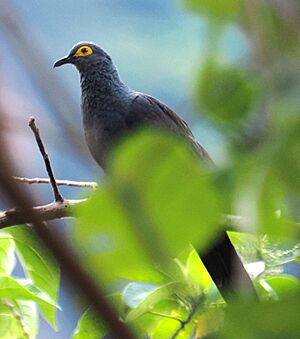Black cuckoo-dove facts for kids
Quick facts for kids Black cuckoo-dove |
|
|---|---|
 |
|
| Conservation status | |
| Scientific classification | |
| Genus: |
Turacoena
|
| Species: |
modesta
|
| Synonyms | |
|
|
The black cuckoo-dove (Turacoena modesta) is a special kind of bird in the dove family. It's also known as the black dove. This bird lives only on a few islands in Southeast Asia. You can find it on Timor, Wetar, Rote, and Atauro. It likes to live in primary and secondary monsoon forest, eucalyptus forests, and woodlands.
This dove is about 38.5 cm (15 inches) long. It's mostly a dark bluish-gray color. Its head and belly are a bit lighter. Its wings and tail are darker. It also has bright yellow skin around its eyes. The black cuckoo-dove eats fruit. Sadly, it's considered "near threatened" by the International Union for Conservation of Nature (IUCN). This means its population is getting smaller. It's mainly in danger because its forest homes are being destroyed and because of hunting.
Contents
About the Black Cuckoo-Dove
How it Got its Name
A Dutch scientist named Coenraad Temminck first described this bird in 1835. He called it Columba modesta. Later, other scientists moved it to different groups. Finally, in 1856, it was placed in the group Turacoena.
The name Turacoena comes from another bird group, Turacus, and an Ancient Greek word oinas, which means pigeon. The word modesta comes from Latin. It means "plain" or "modest," probably because of the bird's simple colors. The official name for this bird is the black cuckoo-dove. Other names include black dove or Timor black pigeon.
Family Tree
The black cuckoo-dove is one of three species in its group, Turacoena. It is most closely related to the white-faced cuckoo-dove. This bird does not have any different types or subspecies.
What Does it Look Like?
The black cuckoo-dove is a medium-sized bird. It measures about 38.5 to 42 cm (15 to 16.5 inches) long. Both male and female birds look very similar. They are mostly a dark bluish-gray color. The color is lighter on their head and underparts (belly). It gets almost black on their wings and tail.
The feathers on top of their head, neck, and upper back have a cool, shiny look. They can shimmer with green or purple colors. The skin around their eyes is bright yellow. Their eyes have a yellow inner ring and a red outer ring. Their legs and beak are black. Young birds are a bit duller. They have brownish-grey feathers with light, pale fringes.
What Does it Sound Like?
The black cuckoo-dove has a unique call. It starts with soft purring sounds. These are similar to those made by the European turtle dove. Then, it changes into a series of quick, stuttering notes. The call slowly fades away. It sounds like "crrruah...crrruah..rrah.rah.ra.ra.ra-ra-ra-r-r-r-r". This call lasts about 6 to 8 seconds. It has about 20 to 25 notes. The bird repeats this call about every half minute.
Where Does it Live?
The black cuckoo-dove lives only on the Lesser Sunda Islands. You can find it on Timor, Wetar, Rote, and Atauro. It lives in both old-growth and newer monsoon forests. It also lives in eucalyptus forests and woodlands. These birds can be found at heights of up to 1,770 meters (5,800 feet). They can handle some habitat destruction, but not too much. Scientists think they might move around during different seasons to find food.
How Does it Behave?
The black cuckoo-dove is usually seen alone or in pairs. They often stay in the lower parts of the forest canopy. They are quiet birds. If something scares them, they fly quickly to a nearby branch. They eat fruit. They look for food alone or in pairs in bushes and small trees. Sometimes, many doves gather together at trees that are full of fruit. These birds can sometimes have tiny mites on their flight feathers.
Why is it "Near Threatened"?
The black cuckoo-dove is listed as "near threatened" by the International Union for Conservation of Nature (IUCN). This is because its population is shrinking. Also, it only lives in a few places. Scientists believe there are about 1,500 to 7,000 adult birds left. The total number of individuals is estimated to be between 2,500 and 9,999.
The biggest dangers to this bird are deforestation and hunting. Deforestation means that their forest homes are being destroyed. This happens because of grazing animals, fires, farming, and logging. In Timor, the birds are also threatened by a lot of hunting.



